Search the Omeda Knowledge Base
Odyssey – Voyage Templates
Odyssey – Voyage Templates
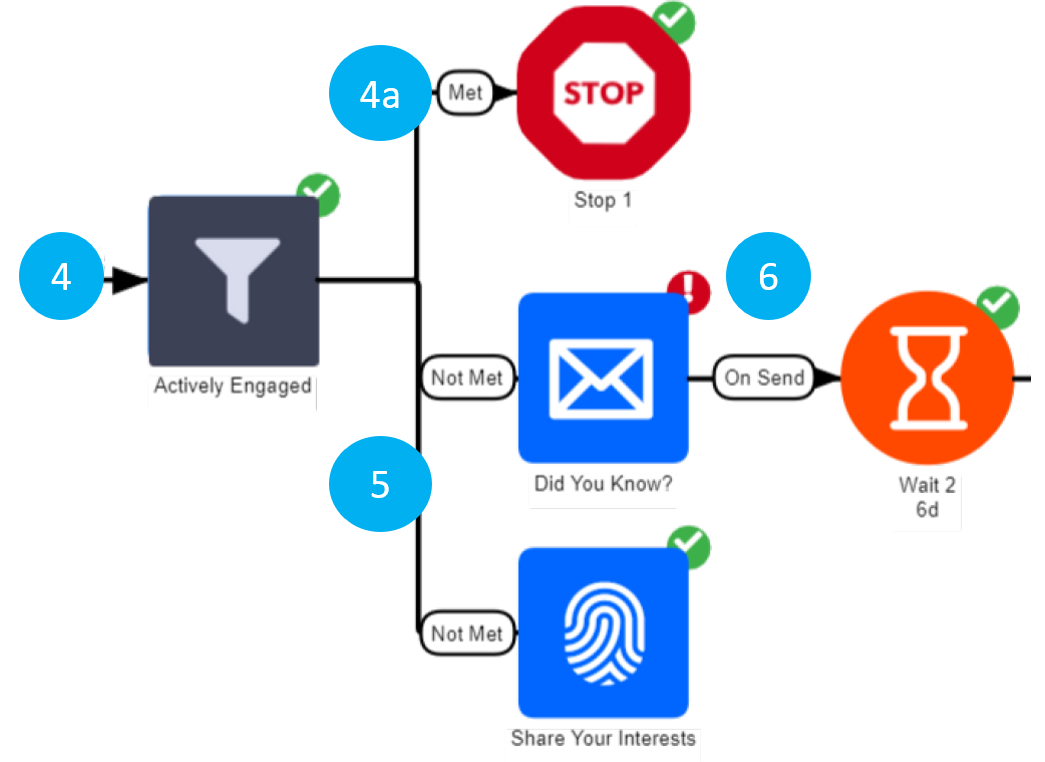
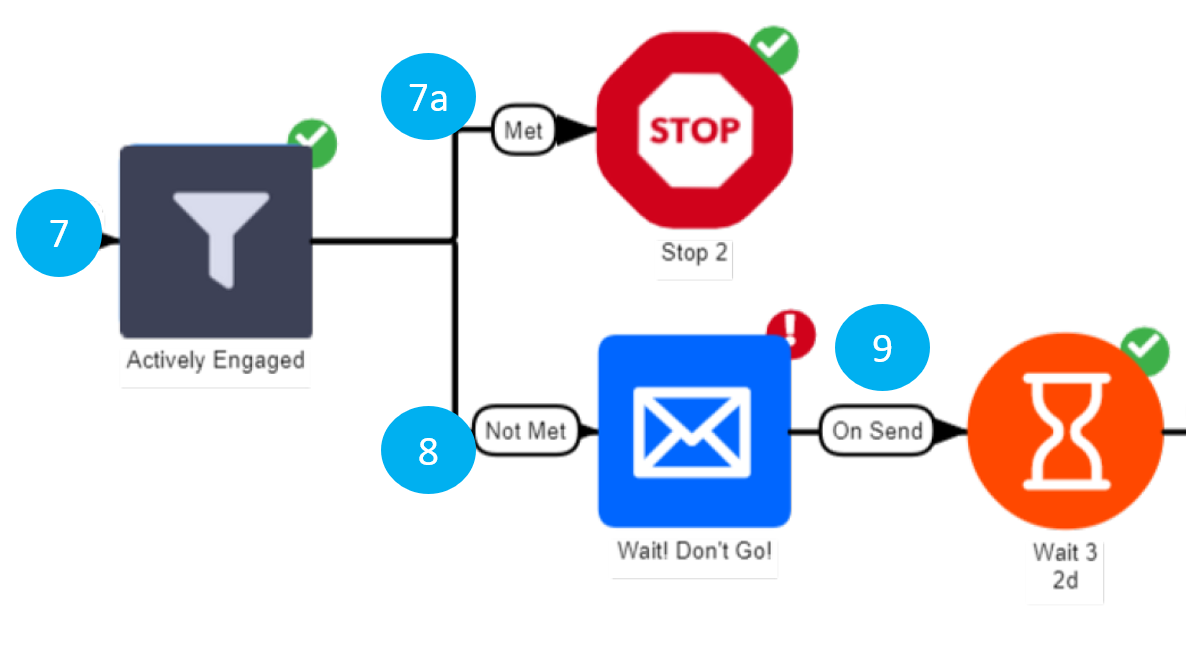
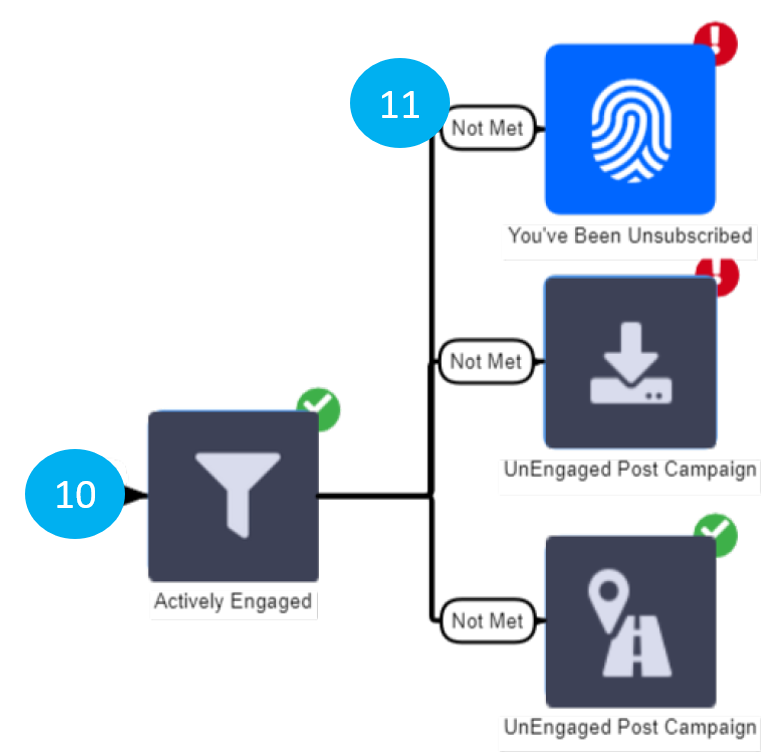
Voyage Templates in Odyssey – Introduction
A good template can help save you time and keep your Odyssey voyages organized. Templates load without any data and it can sometimes be a challenge to apply your processes to an empty flow. The following templates are coming soon!
- Converting Anonymous to Known
- Welcome Series – Branched
- Re-Engagement V1 – Valid Email
- Re-Engagement V2 – Invalid Email
- Cross-Promotion
To get you started, here are detailed outlines for each of these voyages so you can get up and running even sooner.
Template #1 – Converting Anonymous Visitors to Known
Goal: To engage with anonymous visitors in order to convert them to known
Purpose: To target those who are engaging your materials but are not providing their information. Dual purpose, it also gives an easy way for an anonymous person to opt-in to receiving additional materials.
Length of Campaign: ~1 week/person
Campaign Type: Continuous
Suggested logic for Audience Builder: Select anonymous visitors; consider limiting it to those who have recently engaged with your website and/or engaged X times within a specific date range. Build a separate Odyssey for each Brand for best targeting results.
Summary:
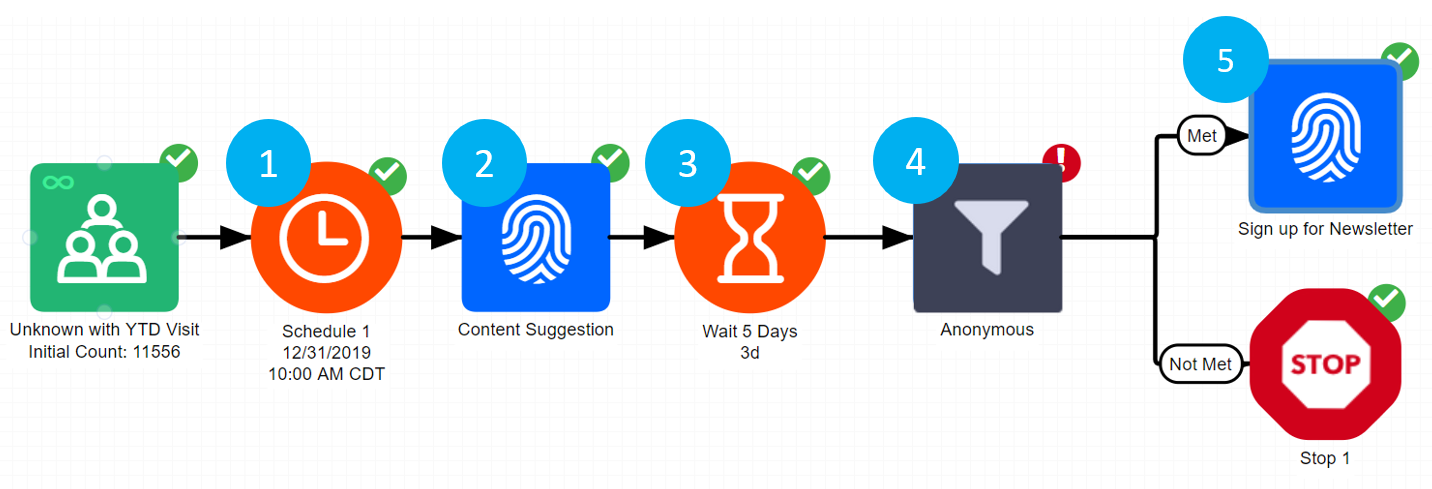
- Schedule: Set up the date/time of the first set of contacts that you will push through this Odyssey. This will also be used to trigger the subsequent series’ refresh dates (if you select this to run continuously).
- Personalization: Set up a personalization element to fire on your website. For this element to successfully convert people, make sure to capture their contact information (at minimal, email address/country). You can embed a Dragon Form directly into this element in order to let the person sign up from the popup for the best user experience.
Suggested Content: Start by giving your unknown audience something of value to them – highlight a popular piece of content, an article or a white paper. Make sure to require some sort of signup from them before they access it. For design inspiration, check out our Suggested Content HTML template.
PRO TIP: Make sure you restrict by URL in order to prevent this from firing across all your websites.
- Wait Element: Select how long you’d like to give your anonymous visitors before you move to the next part. A good wait time can be determined in part by assessing how often anonymous visitors come to your page. If they come several times in a month, you can use faster wait times, if it takes them awhile to come back, let this sit longer.
- Filter: Once the wait is completed, you can set up a filter to organize your visitors. For this template, there are 2 filter paths, those that are still anonymous and those that are now known. For those that are known, this Odyssey stops, as they have successfully met the goal.
PRO TIP: Depending on your marketing strategy, the contacts who have become known may be filtered into a welcome series now.
- Personalization #2: For returning traffic who haven’t yet converted to known, you can set up a second, more direct personalization. Consider a modal popup, or a persistent header/footer that is more aggressive in its placement.
Suggested Content: Use this space to promote your newsletter(s). You can embed a Dragon Form field to capture their name/email address and automatically opt them into the promoted subscription(s). For design inspiration, check out the Subscription Prompt HTML template
PRO TIP: Depending on your business model, you can also choose to filter those who hit the first personalization, but didn’t convert, over to a meter. This group has a higher chance of coming back a 2nd or 3rd time and would be a good target audience for a reg/pay wall.
How will I know if my voyage was a success?
Use the standard # of conversions from anonymous to known in a set time (e.g. month, quarter) as a baseline indicator for your campaign. If you see an increase in conversions while running this campaign, it’s working!
If the results are not as positive as you’d like, consider tweaking the following:
- Update your audience to see if you need to make it more (or less) inclusive
- Look at the timing elements to see if you need to let things sit longer (or shorter) between runs
- Review the messaging for 1) Clear CTA, 2) audience-appropriate messaging, 3) placement of personalization and 4) general design
- Adjust the fields you are requiring them to give you for content. If they are not willing to give you an email address at first, consider changing it to name and country and see how many then engage.
Template#2 – Welcome Series, Branched
Goal: To engage with new subscribers and promote interaction / Highlight a ‘next step’
Purpose: To engage with a new subscriber and welcome them to the newsletter/product that they recently subscribed to. For added benefits, have a ‘ beyond just being a subscriber. You can use this as a chance to promote an event and/or a paid membership/content option (if available).
Length of Campaign: ~1 week (can be adjusted to 2-4 weeks as needed)
Campaign Type: Continuous
Suggested Logic for Audience Builder: Select the contacts who have recently subscribed to a product (can exclude those who opted in for daily emails and/or run it concurrently with their daily emails).
Summary:
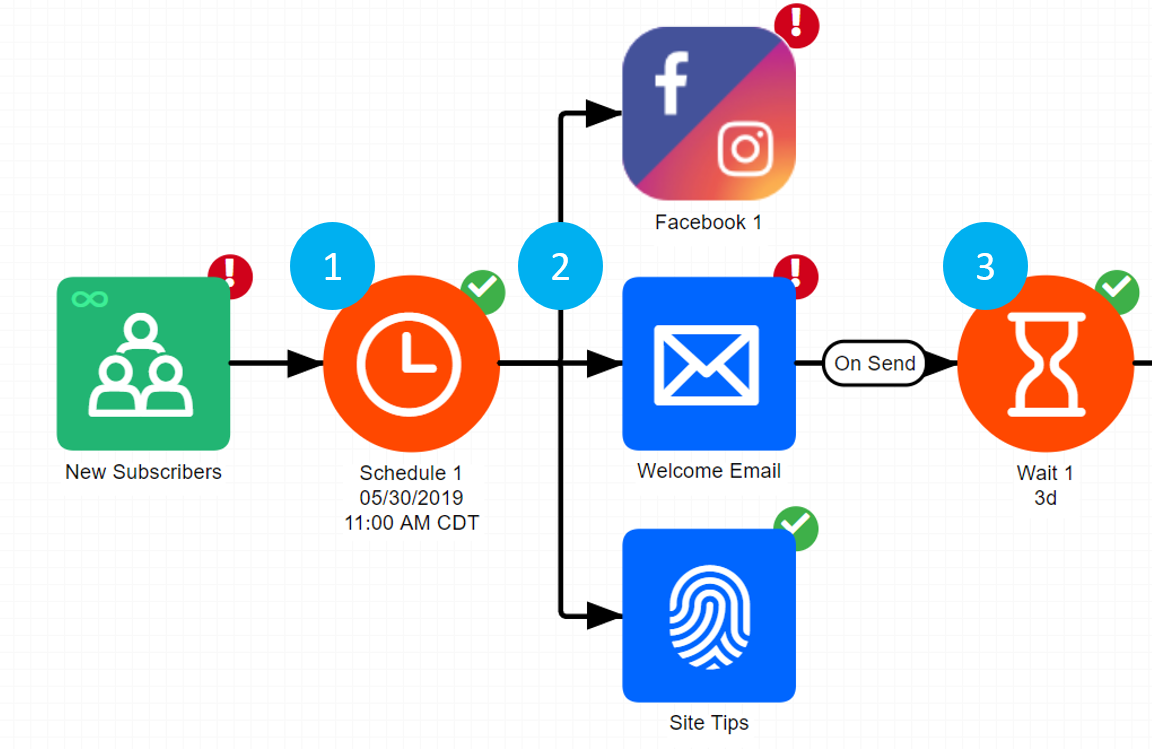
- Schedule: Set up the date/time of the first set of contacts that you will push through this Odyssey. This will also be used to run the subsequent series’ (if you select this to run continuously).
Pro Tip: If you are running this for contacts who opted into a daily email, consider setting this deliverability time to run a few hours after their daily email is delivered in order to decrease the chance for email fatigue.
- Email #1 / Personalization / FB-Instagram: This first email welcomes the new subscriber to your product, and can be expanded to engage them across 2 other channels (Website & FB/IG)
Suggested Content: Consider writing a welcome letter from the team, the CEO, or the editors. It is a nice personal touch that keeps the human element in your digital products. For formatting, check out the Welcome Message Template
For the personalization, consider sharing some site tips that guide readers to different parts such as FAQs, Special reports/whitepapers, and/or general website use. If your site works best with a specific browser, note that here too. For easy formatting, check out the Welcome Message Template
For FB/Instagram, highlight a piece of content and/or a whitepaper that your new subscriber may find appealing.
- Wait: There is nice flexibility here with this element, depending on how long you’d like your total campaign to run. You can set the wait to be a few days up to a week. We recommend 3-5 days so that you don’t trigger email fatigue but are still consistently visible for the new subscriber.
Pro Tip: For this template example, we filtered the subscribers into 2 groups based on their job function(s) in order to provide more relevant content. You can add extra filters at this point, or, if you want to run everyone together, consider using the alternative Welcome Series Template.
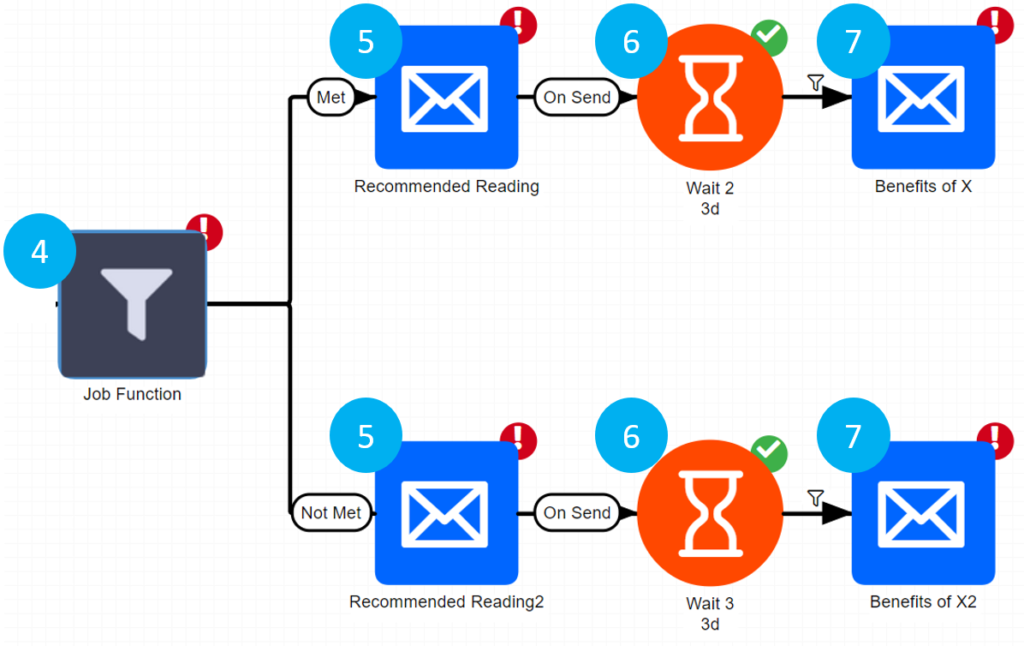
- Filter: In order deliver more direct content, you can choose to filter your recipients into two or more segments where they can receive content more relevant to themselves. For example, you can build a filter on job function that may push the C-suite level contacts down a different path than the operations team subscribers.
- Email: Send different emails to each of your filter groups. Depending on how you’ve filtered your contacts, you may have 2 different call to action elements.
Suggested Content: Highlight articles, a white paper, or a report that is relevant to your filtered target group. This is your chance to impress your new subscribers with how relevant your content is going to be. For design inspiration, check out our Content Highlight email template
- Wait: Your 2nd wait element can mirror the first one for consistency, the length can vary depending on how long you’d like your campaign to run.
- Final Email: This final email wraps up the welcome series. It can be the same across all filter groups, or you can leave ending messages that vary depending on your group.
Suggested Content: Have a clear ‘What’s Next’ CTA. Highlight an upcoming event, promote a featured article, etc. This is a great place to put sponsored content and/or share content that the subscriber may need to pay for (e.g. a yearly report, special content, a membership option, etc.) For design inspiration, check out our New Product Offering email template or the Product & Event Highlight email template
How will I know if my voyage was a success?
There are two ways you can measure the success of this welcome series. First, if your subscribers engage with your content, then you have satisfied the general goal of promoting engagement.
If you are using this campaign to promote the next step you’d like your subscriber to take, you can measure the success based on how many subscribers answered your Odyssey CTA. Use this as a baseline to establish the baseline for future campaigns.
Look to either or both indications of success and evaluate and edit your Odyssey as needed. Things to consider tweaking for different results can include:
- Subject Lines
- Filters
- Recommended/Promoted Content
- CTAs
Template #3 – Re-Engagement V1: Valid Email Address
Goal: To have contacts who have opted into receiving emails, but who are not opening them, open and/or click on at least one email during the time this campaign is running.
Purpose: To assess/cleanse subscription lists by ensuring that there is still an active person on the other end. Generally, increases open rates & CTRs for subscriptions once this campaign has run.
Length of Campaign: ~2 weeks
Campaign Type: Continuous (monthly or bi-weekly)
Suggested Logic for Audience Builder: Select those who are subscribed to a newsletter and have received X amount of emails. Make sure to exclude those who:
- Have invalid email addresses
- Were newly created (be it in the last X months, YTD, etc)
- Have opened at least X emails since X
Summary:
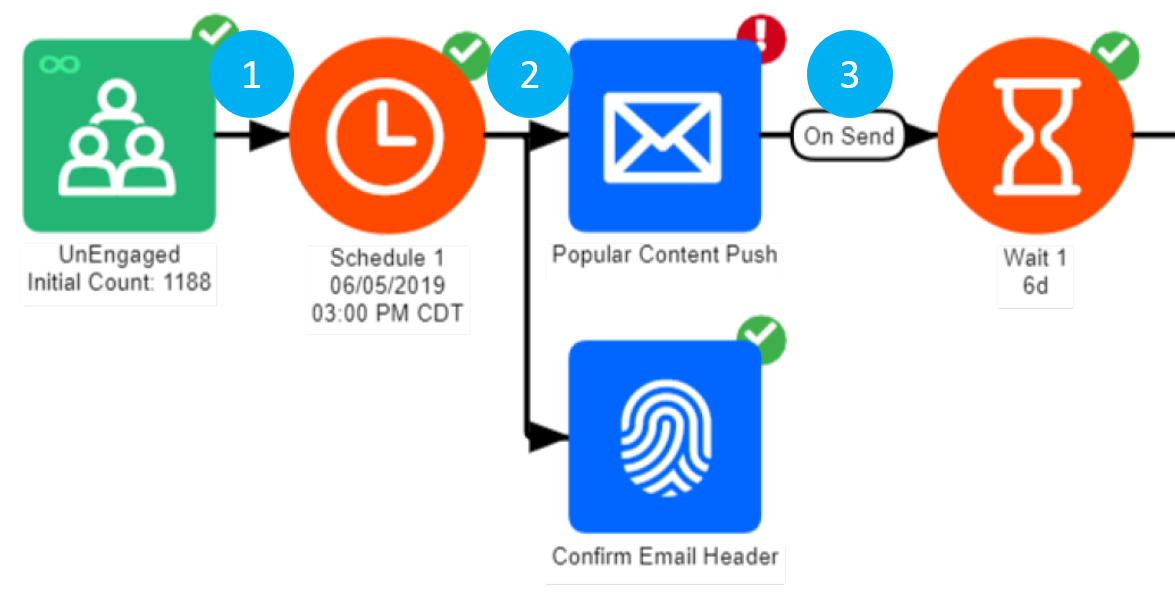
- Schedule: Set up the date/time of the first set of contacts that you will push through this Odyssey. This will also be used to run the subsequent series’ (if you select this to run continuously)
- Email #1/Personalization: Your initial email and personalization can trigger simultaneously. At the same time, you can set up a personalization element to trigger for those that go to your website prompting them to confirm their email address.
Suggested Content: For the initial email, consider highlighting a popular piece of content. Try something that is not like the email content that they have been receiving as that isn’t as attention grabbing. For email design inspiration, check out our Content Highlight email template and for a personalization, check out our Confirm Email HTML template
- Wait: Once the email has sent, there is a waiting period until the next round of elements is triggered. To avoid over-sending emails, a ~6 day waiting period is recommended. After the wait, the filter will be activated.
- Filter: Before running the next set of elements, set up a filter to remove those who engaged with an email.
4a. If someone has opened and/or clicked an email during the 6 day wait, they have satisfied the goal of this entire campaign and are done.
- Email #2/Personalization: For those that are still not engaging, send a second email. For additional engagement, you can also set up a Personalization element to trigger at the same time.
Suggested Content: Consider highlighting some of the product offerings that you have. It’s a nice reminder and may trigger the contact to re-engage. For design inspiration, consider using the Product & Event email template or the New Product Offering email template.
For the Personalization element, try inserting a Dragon Form that prompts people to select content that they would like to see more of. Use this later on to better target them with products and content that they prefer. You could also use this space to highlight engaging content. For design inspiration, see our Suggested Content HTML template
- Wait: This is the 2nd wait and follows the same pattern as the first wait. Suggested wait time is ~6 days
- Filter: Add the same filter as #4, removing those that have engaged with an email since the last email was sent (7a).
- Email #3: For those that still aren’t engaging with any of your email content, they will receive this final email in the series.
Suggested Content: Have a clear CTA and an associated consequence. For example, you can advise that you will be removing them from the recipient list and that they will need to re-subscribe unless they confirm they are still interested. For design inspiration, consider using the Welcome Message email template
- Wait: Final wait in this campaign. As there is no more content being sent in this Odyssey after Email 3, a shorter wait time is acceptable. After 2 days, most activity that will happen is done. This is an acceptable time for triggering the final set of elements.
- Filter: Set the final filter as the same as the previous 2. For those that have engaged with any email, they have met the re-engagement criteria and are done.
- Final Steps: For those that haven’t engaged in your specified period of time and have not engaged with your 3 emails as part of this campaign, you can set up a personalization to run notifying them of either 1) They’ve been unsubscribed or 2) prompt them to change their email preferences (this will tie in with the content you sent in email #3 (Bubble #8))
Additionally, you export the list of those who remain unengaged or drop them onto an FTP site for further action.
Lastly, you can drop a pathfinder in OnQ to easily identify these contacts anytime in the future and/or exclude them from future emails so that they won’t bring down your metrics.
How will I know if my voyage was a success?
There are 2 key factors in determining how successful this campaign was. First, if people who weren’t previously engaging, open or click through an email, it has met the goal. Additionally, by removing these unengaged contacts from your subscription lists, you will see an increase in open rates and CTRs.
As you evaluate the first campaign results, you will begin to gather information that will allow you to establish your baseline. You’ll be able to set goals for the number of contacts you’d like to re-engage, and you can better hone your messaging to drive the most opens and clicks.
Template #4 – Re-Engagement V2: Invalid Email Address
Goal: Obtain an updated/new email address for subscribers with an invalid email address on file
Purpose: To target current subscribers who have an email address marked as invalid in order that they can provide a new one so that they can continue to receive emails.
Length of Campaign: ~1 week/person
Campaign Type: Continuous
Suggested logic for Audience Builder: Select subscribers to a specific product who no longer have a valid email address on file. For this to work best, each ODY should be built for a specific brand and/or a singular product, so that upon giving the new email, the subscriber is on the list anew.
Summary:
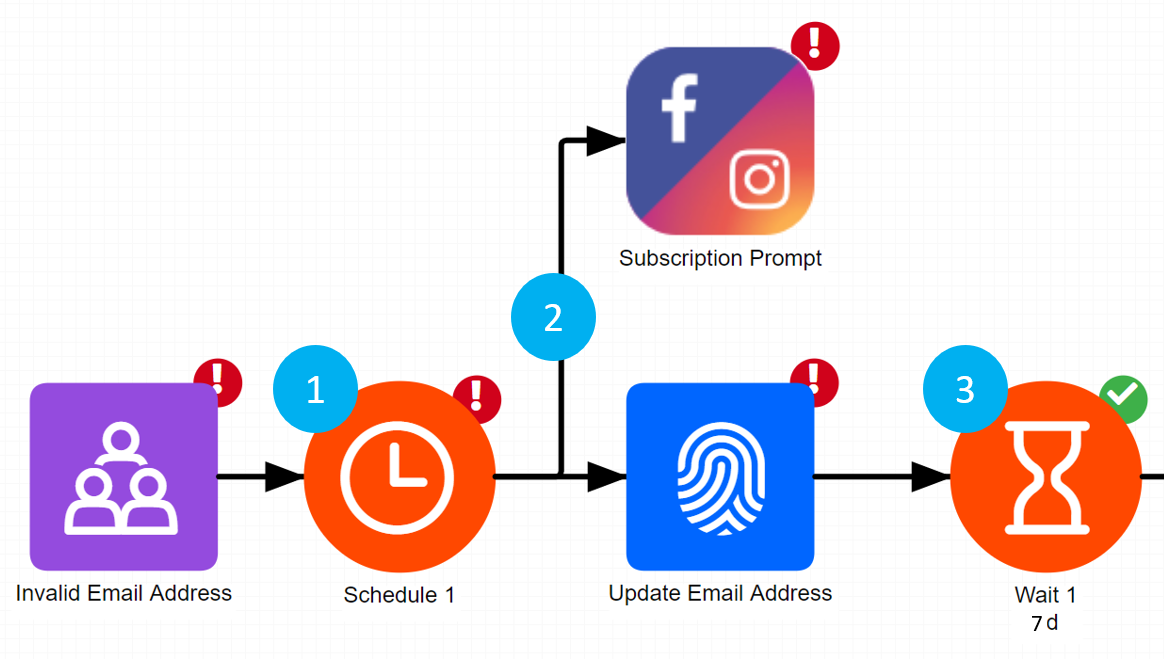
- Schedule: Set up the date/time of the first set of contacts that you will push through this Odyssey. This will also be used to trigger the subsequent series’ refresh dates (if you select this to run continuously).
- Personalization #1 / Facebook/IG: After the wait, you can set up a website personalization and run a FB/IG campaign that run simultaneously.
Suggested Content: Consider having a polite notice on your website that notifies the visitor their email address on file is no longer valid. For design inspiration, consider starting with the Profile Update HTML template and adjusting the verbiage accordingly. You can then have a form field embedded directly into the personalization or a button that redirects them to the profile page. For the FB/IG portion, promote the subscription that the consumer had opted in to receive.
- Wait: This is the only wait in this Odyssey and can be set to mimic the average behavior of your audience. If you have regular, recurring visitors, consider a shorter wait time. If recurring visits aren’t as common, wait a bit longer to ensure you’ve captured the best percentage of your audience.
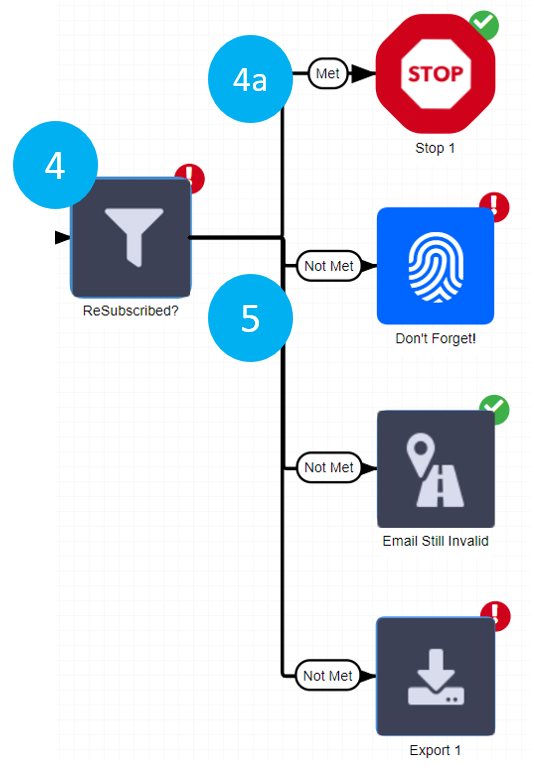
- Filter: Once you’ve given your targeted audience enough time to visit your website and receive the personalization element, you can set the filter to remove those that provided a new email from the Odyssey (4a). They have met the goal of the Odyssey and can now return to the subscription pool (you could also consider putting them back into a welcome series depending on your marketing strategy).
PRO TIP: Simply updating the primary email address on file is not enough to add the subscriber back onto the product recipient list that they were on formerly. The least manual process is that their new email address is added to a product anew, rather than attempting to set it up as a replacement for the invalid one on file.
- Personalization #2 / Pathfinder / Export: For those that did not provide a new email address, you can set up a second personalization. Additionally, you can mark this group of people with a pathfinder to easily identify and target them in new efforts later. Lastly, you can also choose to export these contacts without valid email addresses – potentially feeding them into a telemarketing effort.
Suggested Content: If your first personalization called out those who had an invalid email address, try a different approach this second time around. Consider showing them their email and asking them to confirm if it’s still valid or simply let them know they need to re-subscribe to get back on the list. For email confirmation messaging, check out the Email Confirmation HTML template. Just looking to have them re-subscribe? Try the Subscription Prompt HTML template instead.
How will I know if my voyage was a success?
If, through this campaign, you have subscribers update their information and re-subscribe, your campaign will have been a success. Use the metrics from the initial run to establish a baseline of expectation that can be used to gauge success of future campaigns.
Not getting the desired metrics? Try adjusting the messaging of your personalization elements and make sure you have a clear CTA (e.g. “Your email address has expired, please provide your current email in order to continue receiving valuable content”). Additionally, you can adjust the wait times to better match your audience behavior. You can always revisit your audience query as well to make sure it’s not targeting an audience segment that is too broad or too narrow.
Template #5 – Cross Promotion
Goal: Metrics to be decided as part of the cross-promotion agreement
Purpose: To promote a product or content piece from a paid advertiser
Length of Campaign: ~2 weeks
Campaign Type: Static
Suggested Logic for Audience Builder: Audience will depend on the type of cross promotion that you are running. Logic may target demos such as job function, location, type of product(s) purchased, etc.
Summary:
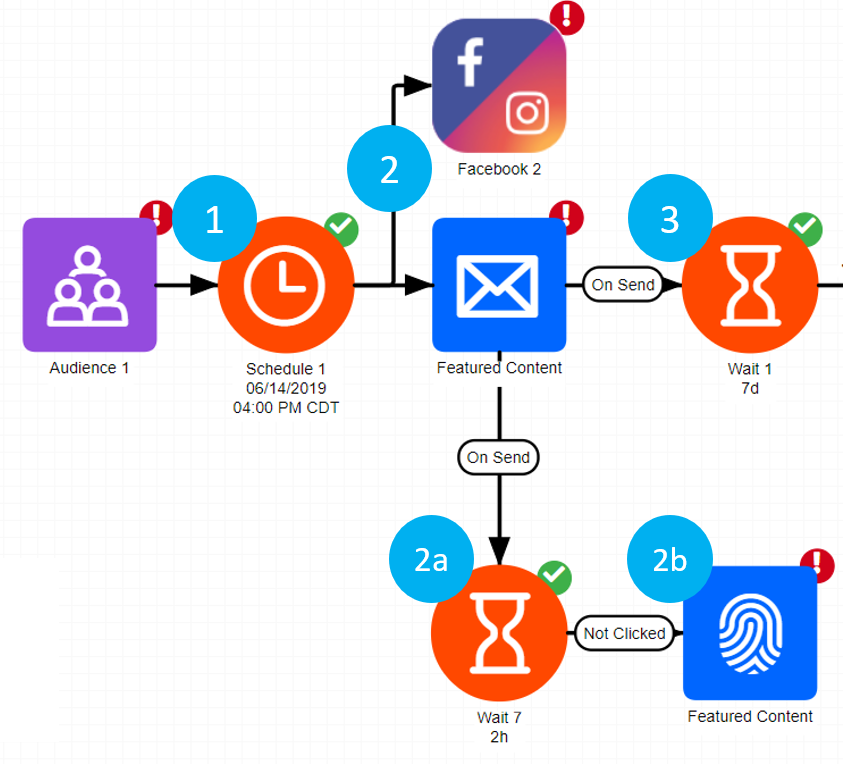
- Schedule: Set up the date/time of the first set of contacts that you will push through this Odyssey.
- Email #1/FB: On schedule, the initial email will be sent out. You can simultaneously run a Facebook/IG campaign for maximum reach.
Suggested Content: Highlight the content or product that you are cross-promoting. Identify and explore the pain point(s) that the promoted content/product addresses. For design inspiration, try the Content Highlight email template or the Articles & Subscription Push email template
2a. Once you send the email, wait ~2 hours and then set a personalization to trigger (2b). This personalization can highlight the same content piece and/or CTA that you sent in your email. Check out the Suggested Content HTML template for design inspiration.
2b. When you set up your personalization, you can set a soft filter by choosing to limit this to those who didn’t open/didn’t click the initial email. This will prevent them from seeing double messages. You can also drop a filter here depending on how cautious you are to show the same message to people twice.
- Wait: Your first wait element can range from 3-7 days, depending on how frequently you would like to target your newcomers with content. For this example and timeline, we set it to 7 days
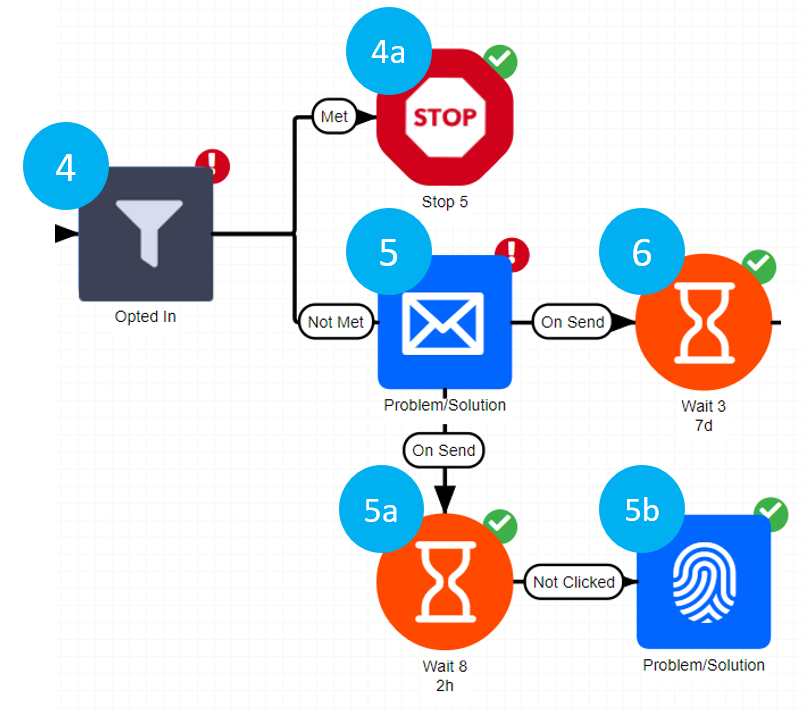
- Filter: After the wait, you can filter out your audience. If they have met the goal of your campaign (e.g. opt in to a product), they can be removed from the Odyssey (4a)
PRO TIP: Depending on how your cross promotion is set up, qualified contacts may be filtered over into a new Odyssey/next phase
- Email #2: For those that have not yet met the goal of the campaign, you can send a 2nd Much like the first round, you can set a short wait (5a), followed by a new personalization element (5b)
Suggested Content: For this 2nd email, try a different design layout. If the initial email was a more creative HTML, consider paring this down to a simpler text version. For the Personalization element, consider changing the placement on the website and the promoted call to action.
- Wait: You can set this next wait element to 5-7 days, depending on the overall timeline for the Odyssey that you have selected. For this template, we have set it to 7 days.
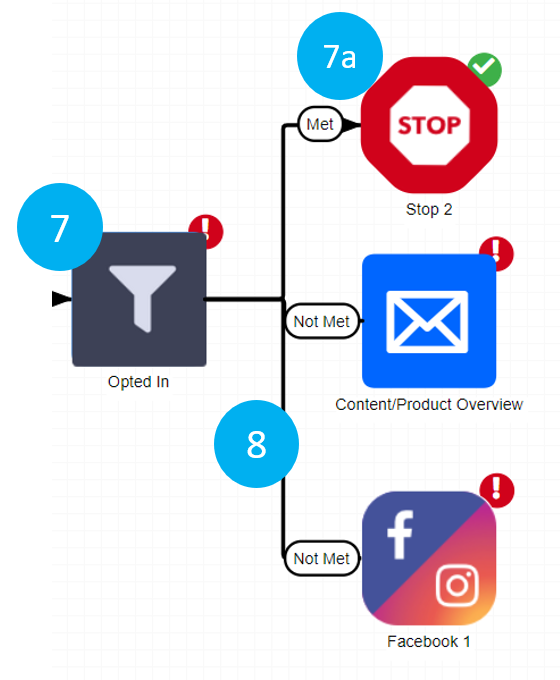
- Filter: Using the same filter as you had set previously, check to see if anyone in the Odyssey has met the goal(s) of this campaign. If they have, you can filter them out (7a).
- Email #3 / FB: This final email is the last chance to capture the attention of your audience. At the same time, you can push them to FB/IG.
Suggested Content: For this 3rd email, experiment with being direct. Address the pain point that is a commonality in your audience and speak to how this promoted item addresses it. If you’re looking to address a few things in one email, try the New Product Offerings email template.
How will I know if my voyage was a success?
A successful cross promotion will benefit both your brand and the one that you are promoting. Depending on the call to action, you will have different ways to measure success. Using this initial Odyssey will also establish a nice baseline against which to measure future Odysseys.
Make sure to evaluate your campaign regularly; if you are not fully satisfied with the results, adjust both the messaging and the patterning of the elements in order to find what works best for your brand and your consumers.
PRO TIP: For advanced cross-promotion, you can branch out after each email and address the consumers differently depending on if they opened/clicked the email or not. Consider re-sending email content for those that didn’t open it initially, experimenting with wait times and subject lines.
Questions on your emails, reporting or deliverability? Reach out to our Email Success team at emailsuccess@omeda.com. For questions regarding specific use cases, strategic planning or additional template customization, contact Client Success at clientsuccess@omeda.com